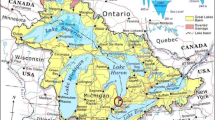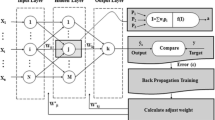Abstract
In recent years, the data-driven modeling techniques have gained more attention in hydrology and water resources studies. River runoff estimation and forecasting are one of the research fields that these techniques have several applications in them. In the current study, four common data-driven modeling techniques including multiple linear regression, K-nearest neighbors, artificial neural networks and adaptive neuro-fuzzy inference systems have been used to form runoff forecasting models and then their results have been evaluated. Also, effects of using of some different scenarios for selecting predictor variables have been studied. It is evident from the results that using flow data of one or two month ago in the predictor variables dataset can improve accuracy of results. In addition, comparison of general performances of the modeling techniques shows superiority of results of KNN models among the studied models. Among selected models of the different techniques, the selected KNN model presented best performance with a linear correlation coefficient equal to 0.84 between observed flow data and predicted values and a RMSE equal to 2.64.











Similar content being viewed by others
Explore related subjects
Discover the latest articles and news from researchers in related subjects, suggested using machine learning.References
Abrahart RJ (2003) Neural network rainfall-runoff forecasting based on continuous resampling. J Hydroinf 5(1):51–61
Abrahart RJ, See L (2000) Comparing neural network and autoregressive moving average techniques for the provision of continuous river flow forecasts in two contrasting catchments. Hydrol Process 14:2157–2172
Aqil M, Kita I, Yano A, Nishiyama S (2007) A comparative study of artificial neural networks and neuro-fuzzy in continuous modeling of the daily and hourly behaviour of runoff. J Hydrol 337:22–34
Bozorg-Haddad O, Zarezadeh-Mehrizi M, Abdi-Dehkordi M, Loaiciga HA, Marini MA (2016) A self-tuning ANN model for simulation and forecasting of surface flows. Water Resour Manag 30(9):2907–2929
Brath A, Montanari A, Toth E (2002) Neural networks and non-parametric methods for improving realtime flood forecasting through conceptual hydrological models. Hydrol Earth Syst Sci 6(4):627–640
Chandwani V, Vyas SK, Agrawal V, Sharma G (2015) Soft computing approach for rainfall-runoff modelling: A review. Aquatic Procedia, 4, International Conference on Water Resources, Coastal and Ocean Engineering (ICWRCOE 2015), p 1054–1061
Chen SH, Lin YH, Chang LC, Chang FJ (2006) The strategy of building a flood forecast model by neuro-fuzzy network. Hydrol Process 20:1525–1540
Elshorbagy A, Corzo G, Srinivasulu S, Solomatine DP (2010a) Experimental investigation of the predictive capabilities of data driven modeling techniques in hydrology - Part 1: Concepts and methodology. Hydrol Earth Syst Sci 14:1931–1941
Elshorbagy A, Corzo G, Srinivasulu S, Solomatine DP (2010b) Experimental investigation of the predictive capabilities of data driven modeling techniques in hydrology - Part 2: Application. Hydrol Earth Syst Sci 14:1943–1961
Ghose DK, Panda SS, Swain PC (2013) Prediction and optimization of runoff via ANFIS and GA. Alex Eng J 59:209–220
Haykin S (2009) Neural Networks: A Comprehensive Foundation, 3rd edn. Prentice Hall, New York
Huang W, Xu B, Chan-Hilton A (2004) Forecasting flows in Apalachicola River using neural networks. Hydrol Process 18:2545–2564
Jang JSR (1993) ANFIS: Adaptive-Network-Based Fuzzy Inference System. IEEE Trans Syst Man Cybern 23(3):665–685
Jeong DI, Kim YO (2005) Rainfall-runoff models using artificial neural networks for ensemble streamflow prediction. Hydrol Process 19:3819–3835
Jiang Z, Wang HY, Song WW (2013) Discharge estimation based on machine learning. Water Sci Eng 6(2):145–152
Karlsson M, Yakowitz S (1987) Nearest-neighbor methods for nonparametric rainfall-runoff forecasting. Water Resour Res 23(7):1300–1308
Kumar P, Alameda JC, Bajcsy P, Folk M, Markus M (2006) Hydroinformatics: data integrative approaches in computation, analysis, and modeling. CRC Press
Lall U, Sharma A (1996) A nearest neighbor bootstrap for resampling hydrologic time series. Water Resour Res 32(3):679–693
Lee T, Ouarda TBMJ (2010) Long-term prediction of precipitation and hydrologic extremes with nonstationary oscillation processes. J Geophys Res 115:D13107
Lee T, Ouarda TBMJ (2011) Identification of model order and number of neighbors for k-nearest neighbor resampling. J Hydrol 404:136–145
Mehrotra R, Sharma A (2006) Conditional resampling of hydrologic time series using multiple predictor variables: A K-nearest neighbour approach. Adv Water Resour 29:987–999
Minns AW, Hall MJ (1996) Artificial neural networks as rainfall-runoff models. Hydrol Sci J 41(3):399–417
Mukerji A, Chatterjee C, Raghuwanshi NS (2009) Flood forecasting using ANN, Neuro-Fuzzy, and Neuro-GA models. J Hydrol Eng 14:647–652
Nourani V, Hosseini Baghanam A, Adamowski J, Gebremichael M (2013) Using self-organizing maps and wavelet transforms for space-time pre-processing of satellite precipitation and runoff data in neural network based rainfall-runoff modeling. J Hydrol 476:228–243
Parasuraman K, Elshorbagy A (2007) Cluster-based hydrologic prediction using genetic algorithm-trained neural networks. J Hydrol Eng 12:52–62
Piotrowski AP, Napiorkowski JJ (2011) Optimizing neural networks for river flow forecasting – Evolutionary Computation methods versus the Levenberg-Marquardt approach. J Hydrol 407:12–27
Prairie JR, Rajagopalan B, Fulp TJ, Zagona EA (2006) Modified K-NN model for stochastic streamflow simulation. J Hydrol Eng 11:371–378
Pramanik A, Panda RK (2009) Application of neural network and adaptive neuro-fuzzy inference systems for river flow prediction. Hydrol Sci J 54(2):247–260
Salas JD, Lee T (2010) Nonparametric simulation of single-site seasonal streamflows. J Hydrol Eng 15:284–296
Sharifazari S, Araghinejad S (2015) Development of a nonparametric model for multivariate hydrological monthly series simulation considering climate change impacts. Water Resour Manag 29(14):5309–5322
Silva-Ramírez EL, Pino-Mejías R, López-Coello M (2015) Single imputation with multilayer perceptron and multiple imputation combining multilayer perceptron and k-nearest neighbours for monotone patterns. Appl Soft Comput 29:65–74
Solomatine DP, Maskey M, Shrestha DL (2008) Instance-based learning compared to other data-driven methods in hydrological forecasting. Hydrol Process 22:257–287
Solomatine DP, Ostfeld A (2008) Data-driven modelling: some past experiences and new approaches. J Hydroinf 10(1):3–22
Takagi T, Sugeno M (1985) Fuzzy identification of systems and its applications to modeling and control. IEEE Trans Syst Man Cybern 1:116–132
Talei A, Chua LHC (2012) Influence of lag time on event-based rainfall-runoff modeling using the data driven approach. J Hydrol 438-439:223–233
Talei A, Chua LHC, Quek C, Jansson PE (2013) Runoff forecasting using a Takagi-Sugeno neuro-fuzzy model with online learning. J Hydrol 488:17–32
Talei A, Chua LHC, Wong TSW (2010) Evaluation of rainfall and discharge inputs used by Adaptive Network-based Fuzzy Inference Systems (ANFIS) in rainfall–runoff modeling. J Hydrol 391:248–262
Zadeh LA (1965) Fuzzy sets. Inf Control 8:338–353
Author information
Authors and Affiliations
Corresponding author
Ethics declarations
Funding and Conflict of Interest
This research did not receive any specific grant from funding agencies in the public, commercial, or not-for-profit sectors. Also, the authors declare that they do not have any conflict of interest.
Rights and permissions
About this article
Cite this article
Ahani, A., Shourian, M. & Rahimi Rad, P. Performance Assessment of the Linear, Nonlinear and Nonparametric Data Driven Models in River Flow Forecasting. Water Resour Manage 32, 383–399 (2018). https://doi.org/10.1007/s11269-017-1792-5
Received:
Accepted:
Published:
Issue Date:
DOI: https://doi.org/10.1007/s11269-017-1792-5




